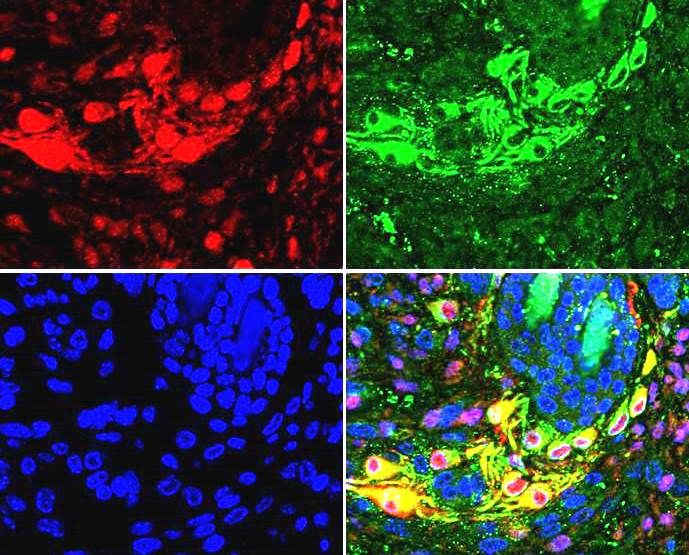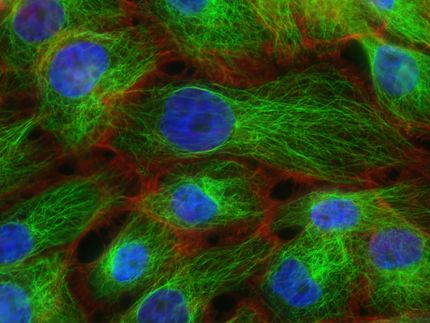Proven biochemistry methods for new skin cancer therapy
Advertisement
Like all other cells in the body, skin cancer cells need a cholesterol metabolism. With the support of the Austrian Science Fund FWF, a Viennese research group discovered deviations and particularities of this process in malignant melanoma that could help improve prognosis and therapy.

Melanomas generally show a high ER stress level, which may be partly responsible for metastasis formation. The image shows a stained melanoma tissue section. The tumour cells are marked in red (top left), a protein indicating ER stress in green (top right), the cell nuclei in blue (bottom left), and the image at the lower right shows the superimposition of the signals.
Clemens Röhrl/MUW
For many years, patients with cardiovascular complaints have been given recommendations for better nutrition to improve blood cholesterol levels. These recommendations are ultimately based on findings on the role of blood lipids in the metabolism: the absorption, release and distribution of cholesterol has been well investigated, as has the role of cholesterol in signalling chains and in the membrane structure of cells. In a recently completed FWF project, the biochemist Clemens Röhrl and his team at the Centre for Pathobiochemistry and Genetics at the Medical University of Vienna were able to show that completely new insights for the identification and treatment of cancer can be obtained by establishing new connections between known biochemical processes, methods and data. Supported by the Austrian Science Fund, Röhrl has investigated suspicious processes in the cholesterol metabolism of benign and malignant skin cancer cells.
Fatal wanderlust
Malignant melanoma is a rare, but very aggressive type of tumour. If malignant melanoma is detected at a late stage, it will often have scattered/spread, and the affected persons have a poor survival prognosis. Immunotherapy works well against skin cancer in about 30 percent of those treated. Conversely, this means that around 70 percent of patients receive therapy that does not help them, has side effects and involves a high cost. “Currently, there is no way to predict success. Particularly in the case of melanoma, one single specific type of medication is not enough; one needs to attack several weak spots simultaneously”, says Clemens Röhrl in describing the point of departure of his project. This biochemist has specialised in cellular lipid metabolism and knows that all cells in the body, both benign and malignant, need cholesterol. For his standalone project, he collated expertise within the Medical University of Vienna. The cancer researcher Mario Mikula, also from the Centre for Pathobiochemistry and Genetics, was an important cooperating partner in this interdisciplinary project. The team used a proven set of methods to investigate different skin cancer cell lines: cells that form metastases and cells that proliferate in situ.
Wayward cholesterol receptors
The team first conducted in vitro tests to see which cell lines display strong gene activation for the formation of different cholesterol receptors. In addition, they determined which receptors developed more often than others: “We found that the genetic activity relating to the SR-B1 receptor, which binds HDL cholesterol in healthy cells and has a protective function, is particularly high in metastatic skin cancer cells”, explains Röhrl in the interview with scilog. This offers a first basis for a marker that might predict the outcome of therapy. In a subsequent series of experiments, the gene expression for this receptor type was increased or reduced in benign cell cultures. The researchers found that increased gene expression for the SR-B1 receptor also favours metastases in benign cell lines. In order to verify these experimental results, the team used bioinformatic methods to vet existing data sets from skin cancer research specifically for cholesterol receptor activity and survival probability. “We thus gained access to results of human studies without any patients having to undergo additional examinations. In the data sets we also found a correlation between the strong SR-B1 gene expression and a poor survival prognosis in skin cancer patients.”
A further element in the characterisation of skin cancer cells with a dangerous predilection for migration is the “ER stress response”. This biochemical signal is triggered by the central protein synthesis and transport unit of the cell when there is an imbalance in protein production. Subsequently, healthy cells trigger adjustment mechanisms or programmed cell death. In this case, too, metastatic melanomas behave unusually: they show a strong stress signal but do not die. Instead, they release growth factors and are prepared to migrate, i.e. scatter tumour cells. The use of an approved drug, which reduces the ER stress level but has so far been used to treat a different disease, was successful in the isolated cell lines but failed in the animal model. In the mouse model, metastases could not be reduced. Nevertheless, standard methods of metabolic biochemistry in cancer research have built the first bridges, which could pave the way for accompanying therapeutic approaches or abbreviations in the approval of active substances.
Original publication
Kinslechner K, Schörghofer D, Schütz B, Vallianou M, Wingelhofer B, Mikulits W, Röhrl C, Hengstschläger M, Moriggl R, Stangl H and Mikula M.; "Malignant Phenotypes in Metastatic Melanoma are Governed by SR-BI and its Association with Glycosylation and STAT5 Activation"; Molecular Cancer Research; 2018.
Eigner K, Filik Y, Mark F, Schütz B, Klambauer G, Moriggl R, Hengstschläger M, Stangl H, Mikula M and Röhrl C.; "The unfolded protein response impacts melanoma progression by enhancing FGF expression and can be antagonized by a chemical chaperone"; Scientific Reports; 2017.

























































